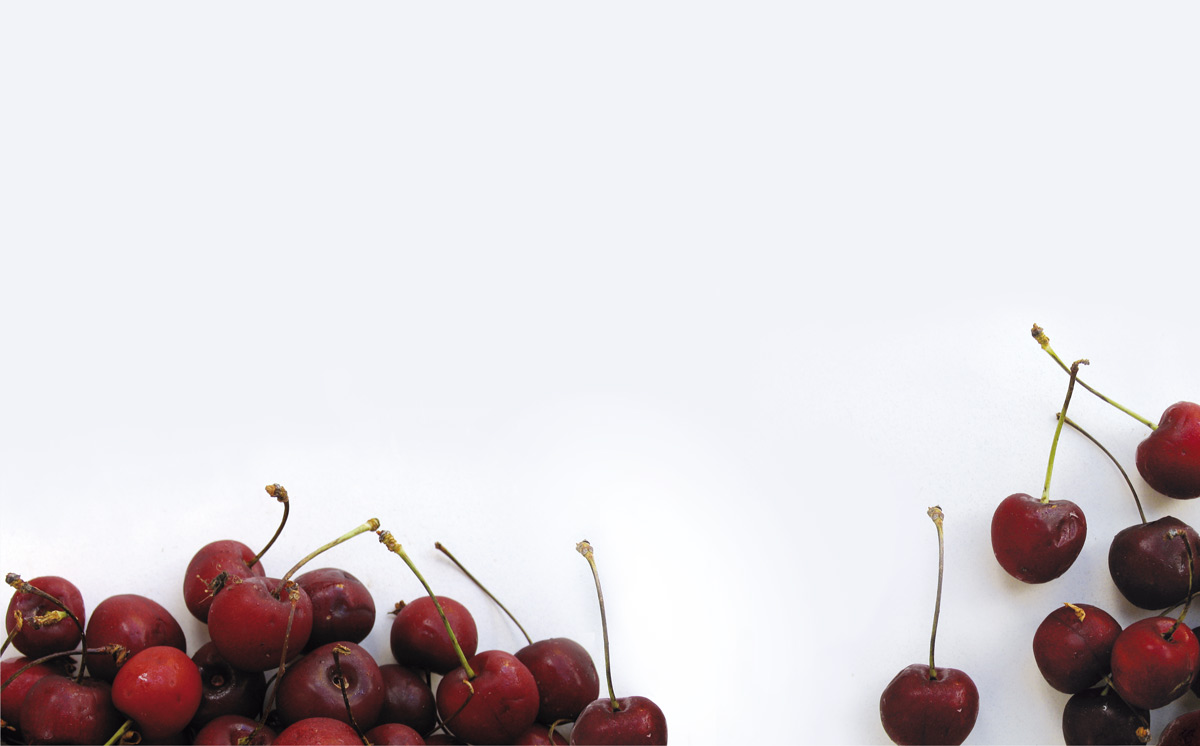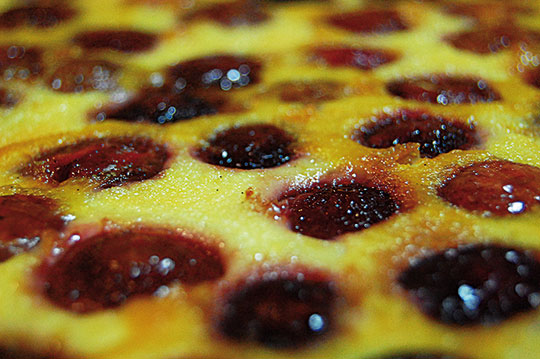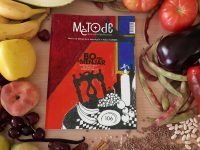
This year the spectacular blooming of cherry trees started in Ahín in late March. Two months later, in late May, we took a short walk around the town and ate the first cherries, delicious, with their subtle flavour. Herminia, who for many years was in charge of the bar of the Sant Ambròs cooperative, told us that the harvest would not be good due to the persistent raining and hailing. On the trees, walnuts, almonds and honeyberries expected summer heat to ripen.
Cherries, plums, peaches, apricots and almonds are all fruit of trees of the Prunus genus. Cherries, in particular, are the fruit of Prunus avium, and there are around 900 varieties in production worldwide. In English we also use the term cherry for morello cherries, the fruit of Prunus cerasus, of which there are 300 varieties. The truth is that cherries and sour cherries are very similar, but the former are sweet and the latter are acidic. Both species are native to western Asia, and were already known to the Greeks, who called them kerasos, whence the word cherry derives.
The taste of fruit is basically due to the sugars and acids they possess; other minor components can also add sour, salty or astringent notes. In cherries, the most abundant sugars are glucose and fructose, and the most common acid is the malic acid.
«The fruits ripen when their seeds are viable: the unpleasant tastes disappear and their characteristic aromas are generated. Animals are attracted to aromas, taste the fruit, eat them and disperse the seeds»
The question of aroma is, how could it be otherwise, far more complex, for several reasons. First, the aroma is the result of a complex mixture of different organic compounds: aldehydes, alcohols, ketones, esters, terpenes, furans, alkenes, phenolic compounds… In cherries, the most abundant aromatic compounds are alcohol (E)-2-hexen-1-ol and hexanal aldehyde, (E)-2-hexanal. These compounds are responsible for the scent of vegetables and herbs. And then we have the benzaldehyde, which is considered one of the key aroma compounds in cherries, and also contributes to the flavour of other fruit trees of the genus Prunus.
However, the aromatic response of a substance and its concentration do not have a linear relationship. In many cases, it is necessary for the substance concentration to be higher than a certain threshold value to be detected. From that value, the aromatic response increases rapidly, and stabilizes at much higher concentrations. If an aromatic substance has a very low threshold, it may contribute to the aroma of a product even in very low concentrations. However, in addition, the perception of a substance can change with an increased concentration: at low concentrations, pentane has bean aroma; at medium concentrations, of sweat and at elevated concentration, manure. Finally, we have already said that the aroma of a fruit comes from many volatile substances, and the combination of volatiles can lead to aromas that are very different from what might be expected from the scents of each individual compound.
The technique to determine the aromas of foods or meals follows, first, a protocol for the extraction of volatile substances. Secondly, these substances are separated according to gas chromatography and detected by mass spectrometry. Now, all these volatile compounds may not have a scent, or they may be present in such low concentrations that they do not contribute to aroma. Therefore, a complementary technique to gas chromatography and mass spectrometry is gas chromatography and olfactometry with dilution analysis. The volatile compounds are separated according to gas chromatography and experts smell them. In addition, the samples are increasingly diluted and subjected to the same procedure, whereby information is obtained on how much a substance contributes to aroma: the more dilutions are necessary for the smelling substance to become indiscernible, the greater its contribution to the aroma.
When these techniques were used with several varieties of cherries, the group of volatile substances that contribute in all cases to its aroma are hexanal, (E)-2-hexenal, (Z)-3-hexenal, nonanal, benzaldehyde and geranylacetone. Also, benzyl alcohol and linalool compounds also contribute to the aroma of many of the varieties tested.
We know from experience that green fruit has an unpleasant taste, and they do not emit volatile compounds. And that is to be expected: the plant tries to produce and disperse as many seeds as possible. Not perceiving volatile compounds, animals do not approach green fruit and, when they do, they do not eat them. On the other hand, the fruits ripen when their seeds are viable: the unpleasant tastes disappear and their characteristic aromas are generated. Animals are attracted to aromas, taste the fruit, eat them and disperse the seeds. Therefore, from an evolutionary point of view, the taste and aroma of ripe fruit provide information about the accessibility of nutrients to the animals consuming them. And in fact, the volatile compounds that contribute to the aroma derive precisely from nutrients: essential fatty acids (linoleic and linolenic acid), essential amino acids (leucine, isoleucine, phenylalanine), carbohydrates, carotenoids (antioxidants)…
Humans are not the only animals eating cherries in the Serra d’Espadà mountain range. Experts say that martens, genets and badgers abound. In a year of sporadic trips, we’ve never seen one. However, at this time of year, their faeces, with abundant cherry pits, betray their invisible presence…
 Clafoutis
Clafoutis
Clafoutis is a delicious baked dessert with cherries typical from the Limousin region in France. The cherries are left in the middle of a kind of pudding, placed with their pit so they generate more benzaldehyde, one of the characteristic scents of the fruit. The dough is made with flour, sugar, eggs and milk, and you can also use ground almond and vanilla. The name has its origin in the Occitan verb clafir, “to fill”.
Ingredients
750 grams of cherries, 100 grams of sugar, 100 grams of flour, 3 eggs, 250 ml milk, butter and salt.
Preparation
Wash the cherries. Sprinkle with 50 grams of sugar and, after mixing, leave to stand for at least 30 minutes. Smear a baking dish with butter, and fill with the cherries. Mix with the flour, the remaining sugar, a little salt, the eggs and milk, using a blender. Pour the preparation over the cherries, and bake in the oven preheated to 180 °C for 35-40 minutes. The cake is served warm, sprinkled with icing sugar.
REFERENCES
Chambers IV, E. and K. Koppel, 2013. «Associations of Volatile Compounds with Sensory Aroma and Flavor: The Complex Nature of Flavor». Molecules, 18: 4.887-4.905. DOI: <10.3390/molecules18054887>.
Davidson, A., 1999. Oxford Companion to Food. Oxford University Press. Oxford.
Goff, S. A. and H. J. Klee, 2006. «Plant Volatile Compounds: Sensory Clues for Health and Nutritional Value?». Science, 311: 815-819. DOI: <10.1126/science.1112614>.
McGee, H., 2007. La cocina y los alimentos: enciclopedia de la ciencia y la cultura de la cocina. Random House Mondadori. Barcelona.
Segnit, N., 2010. The Flavour Thesaurus. Bloomsbury Publishing. London.
Serradilla, M. J. et al., 2012. «Physicochemical and Sensorial Characterisation of Four Sweet Cherry Cultivars Grown in Jerte Valley (Spain)». Food Chemistry, 133: 1.551-1.559. DOI: <10.1016/j.foodchem.2012.02.048>.
Sun, S. Y.; Jiang, W. G. and Y. P. Zhao, 2010. «Characterization of the Aroma-Active Compounds in Five Sweet Cherry Cultivars Grown in Yantai (China)». Flavour and Fragrance Journal, 25(4): 206-213. DOI: <10.1002/ffj.1994>.
V. A., 2011. Larousse Gastronomique en español. Larousse. Barcelona.






